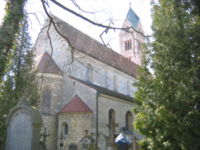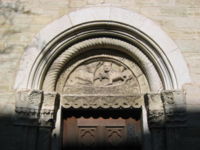
Church of St. Peter (Straubing)
Encyclopedia

Romanesque architecture
Romanesque architecture is an architectural style of Medieval Europe characterised by semi-circular arches. There is no consensus for the beginning date of the Romanesque architecture, with proposals ranging from the 6th to the 10th century. It developed in the 12th century into the Gothic style,...
basilica in Straubing
Straubing
Straubing is an independent city in Lower Bavaria, southern Germany. It is seat of the district of Straubing-Bogen. Annually in August the Gäubodenvolksfest, the second largest fair in Bavaria, is held....
, Germany
Germany
Germany , officially the Federal Republic of Germany , is a federal parliamentary republic in Europe. The country consists of 16 states while the capital and largest city is Berlin. Germany covers an area of 357,021 km2 and has a largely temperate seasonal climate...
. It was built in the second half of the 12th century, and is distinguished by its two sculpted portals. The surrounding cemetery contains a number of funeral chapels, most notably the Totenkapelle, which is decorated with a cycle of paintings depicting the Totentanz
Danse Macabre
Dance of Death, also variously called Danse Macabre , Danza de la Muerte , Dansa de la Mort , Danza Macabra , Dança da Morte , Totentanz , Dodendans , is an artistic genre of late-medieval allegory on the universality of death: no matter one's...
(Dance of the Dead) by the Rococo
Rococo
Rococo , also referred to as "Late Baroque", is an 18th-century style which developed as Baroque artists gave up their symmetry and became increasingly ornate, florid, and playful...
artist Felix Hözl.
Location

Danube
The Danube is a river in the Central Europe and the Europe's second longest river after the Volga. It is classified as an international waterway....
river in the Altstadt of Straubing, approximately one kilometer to the east of the present city center. It sits atop a small bluff, and the cemetery, church, and chapels are enclosed by a wall.
History
The present church is at least the second to have stood on the site; excavations conducted in 1974 revealed the presence of an earlier CarolingianCarolingian
The Carolingian dynasty was a Frankish noble family with origins in the Arnulfing and Pippinid clans of the 7th century AD. The name "Carolingian", Medieval Latin karolingi, an altered form of an unattested Old High German *karling, kerling The Carolingian dynasty (known variously as the...
hall church. The present church was built around 1200, shortly before the removal of Straubing's main market to a site well to the east (the present-day Neustadt). St. Peter remained, however, the only rectory in Straubing until 1492, when the Church of St. Jakob was built in the Neustadt. The church was redecorated in a Baroque
Baroque
The Baroque is a period and the style that used exaggerated motion and clear, easily interpreted detail to produce drama, tension, exuberance, and grandeur in sculpture, painting, literature, dance, and music...
style sometime before 1696, and an onion-dome was set atop the south-western tower. The Baroque decoration and onion dome were removed in 1866/67 in the course of a historicizing "purification" of the structure. In 1885 the north-western tower, which had previously been only three stories high, was raised to the height of the south-western tower. The most recent restoration was undertaken in 1977/78, at which time the nave was provided with a wooden roof.
Structure

Two portals provide access to the building, one from the west and one from the south. The tympanum
Tympanum (architecture)
In architecture, a tympanum is the semi-circular or triangular decorative wall surface over an entrance, bounded by a lintel and arch. It often contains sculpture or other imagery or ornaments. Most architectural styles include this element....
of the west portal portrays a knight, armed with sword and shield, battling a dragon. The head of a man, whom the dragon has swallowed, is visible between its jaws. The representation may allude to the words of Psalm 35/34:
Take hold of shield and buckler, and stand up for mine help. Draw out also the spear, and stop the way against them that persecute me: say unto my soul, I am thy salvation.
The scene would therefore have Christological significance, with the words of the Psalm understood typologically
Typology (theology)
Typology in Christian theology and Biblical exegesis is a doctrine or theory concerning the relationship between the Old and New Testaments...
to refer to Christ as a warrior against evil.

Griffin
The griffin, griffon, or gryphon is a legendary creature with the body of a lion and the head and wings of an eagle...
or another dragon, and at right a lion. The two beasts may likewise be engaged in battle. An opposition between good and evil, similar to that on the west portal, is likely intended, perhaps with reference to medieval animal stories such as those found in the Physiologus
The Physiologus
The Physiologus is a didactic text written or compiled in Greek by an unknown author, in Alexandria; its composition has been traditionally dated to the 2nd century AD by readers who saw parallels with writings of Clement of Alexandria, who is asserted to have known the text, though Alan Scott has...
.
Chapels

Agnes Bernauer
Agnes Bernauer was the mistress and perhaps also the first wife of Albert, later Albert III, Duke of Bavaria...
-Kapelle, the burial place of the like-named secret wife of Albert III of Bavaria
Albert III, Duke of Bavaria
Albert III the Pious of Bavaria-Munich , , since 1438 Duke of Bavaria-Munich. He was born to Ernest, Duke of Bavaria and Elisabetta Visconti, daughter of Bernabò Visconti.-Life:Albert was born in Munich....
, executed on charges of witchcraft; and the Totenkapelle (Chapel of the Dead), built in 1486. The latter is perhaps of the greatest artistic significance, on account of its extensive cycle of paintings representing the Totentanz
Danse Macabre
Dance of Death, also variously called Danse Macabre , Danza de la Muerte , Dansa de la Mort , Danza Macabra , Dança da Morte , Totentanz , Dodendans , is an artistic genre of late-medieval allegory on the universality of death: no matter one's...
(Dance of the Dead), created by the Rococo
Rococo
Rococo , also referred to as "Late Baroque", is an 18th-century style which developed as Baroque artists gave up their symmetry and became increasingly ornate, florid, and playful...
artist Felix Hözl (?-1774), a resident of Straubing, in 1763. The cycle is of note as an 18th-century treatment of a predominantly medieval theme.
Sources
- Alfons Huber: Totentanz- oder Seelenkapelle im Friedhof der Pfarrkirche St. Peter, Straubing (=Schnell Kunstführer Nr. 529). Regensburg, 2003, ISBN 3-7954-6456-0
- Hugo Schnell and Hans Utz: Pfarrkirche St. Peter, Straubing (=Schnell Kunstführer Nr. 1005). Regensburg, 2003, ISBN 3-7954-4739-9
- Richard Strobel and Markus Weis: Romanik in Altbayern. Würzburg, 1994, ISBN 3-429-01616-9

